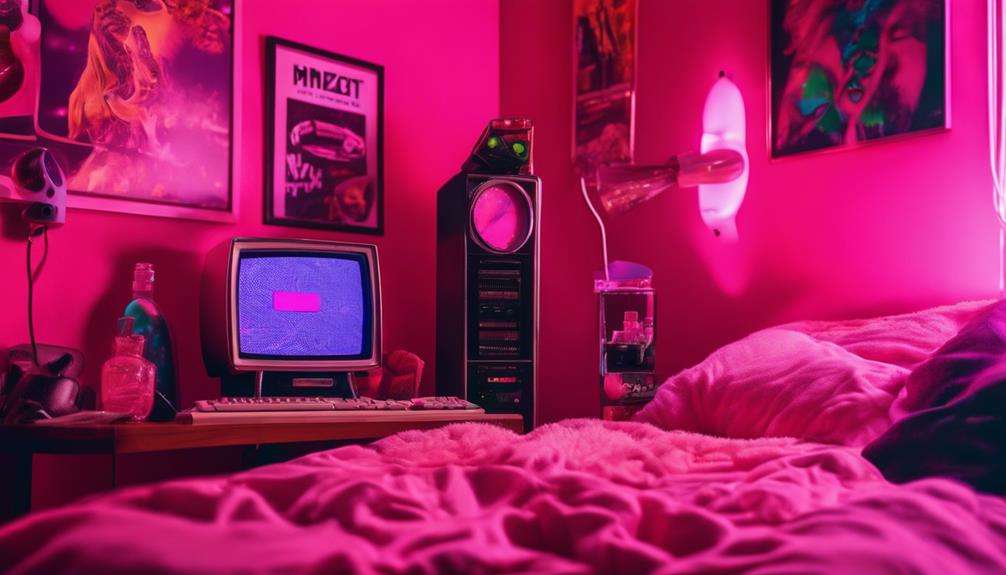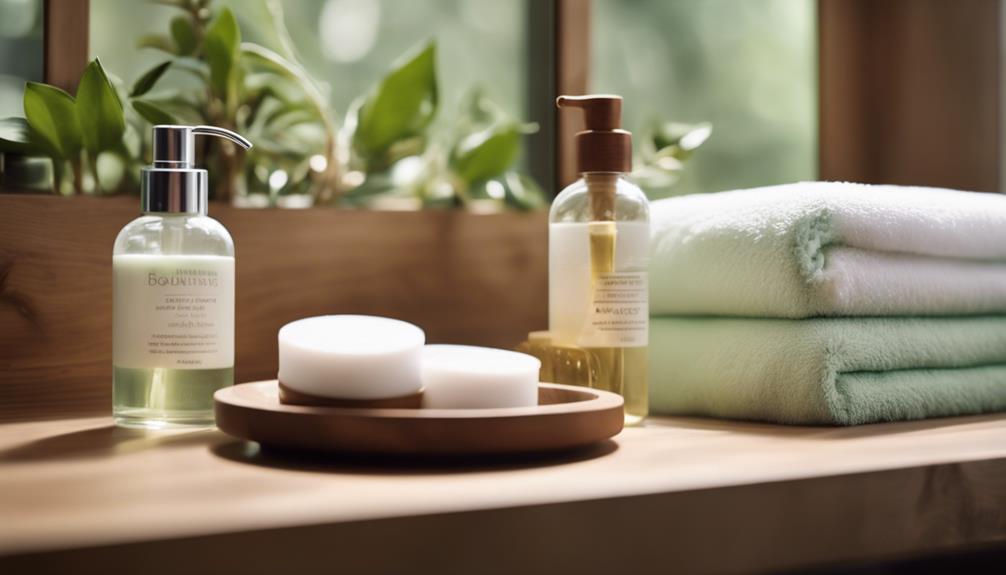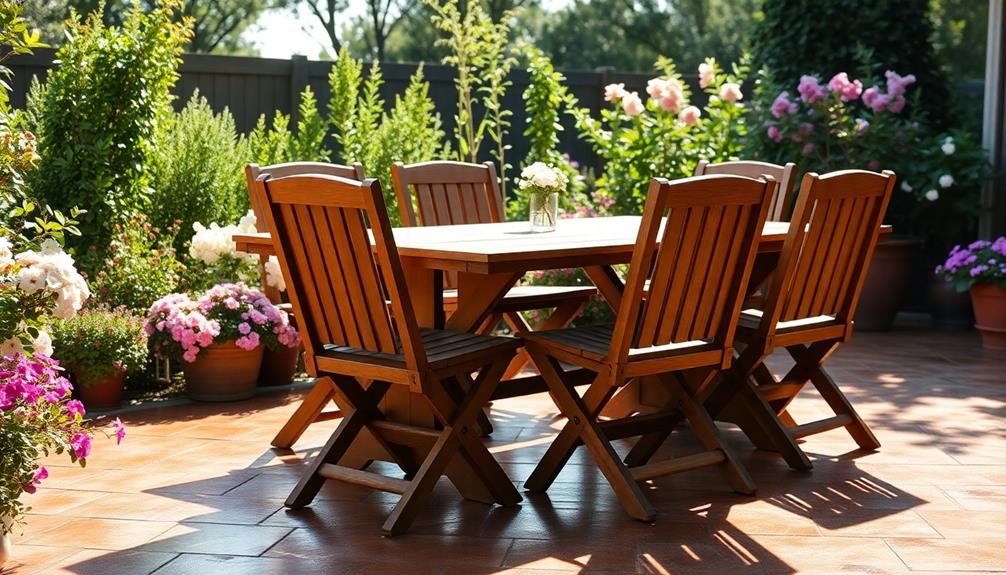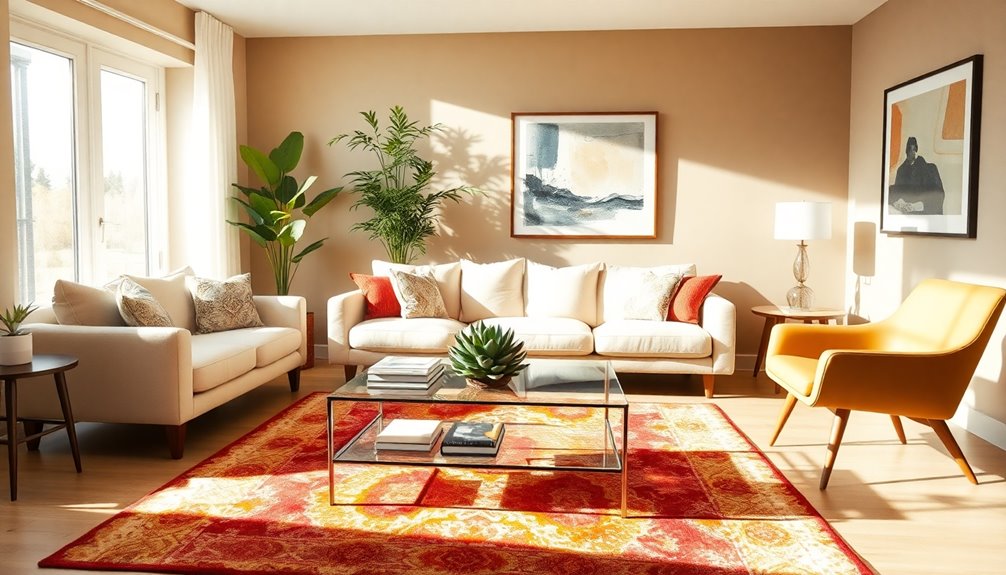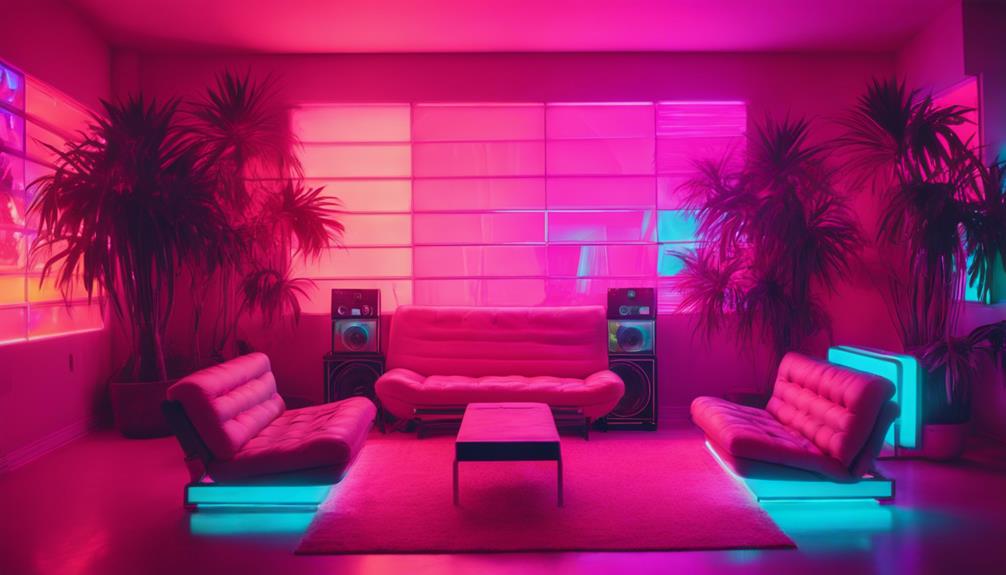Do you want to amaze your friends with a Y2K-inspired room? Begin with a vibrant color scheme featuring hot pink, neon green, and shiny metallics. Soft fabrics such as shaggy bedding add comfort, while inflatable furniture brings a playful element. Opt for disco ball lamps and neon LED strips for lighting to set the mood. Adorn your walls with glittery star stickers and a retro Polaroid photo wall to display your cherished memories. Don’t overlook exciting flooring options like glossy vinyl tiles or neon carpet. Ready to revive the 2000s in style? There’s much more to discover for your ideal Y2K makeover!
Key Elements
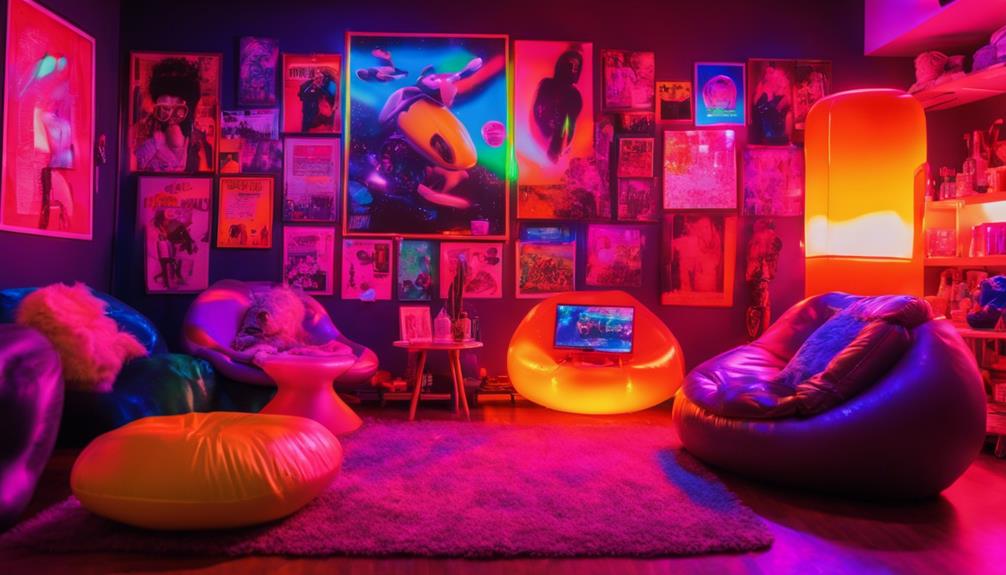
When you're creating your Y2K room, focusing on the right color scheme, materials, and textures is essential.
Bright, bold colors like hot pink and lime green set the playful tone, while inflatable furniture adds a fun, nostalgic element.
Layering in different textures with faux fur and funky rugs keeps your space visually exciting and true to the Y2K vibe.
Color Scheme
The Y2K color scheme bursts with vibrant hues like hot pink, neon green, and bright purple, capturing the era's playful spirit. These bold colors define the aesthetic, making your space feel lively and energetic.
To really nail that early 2000s vibe, consider incorporating metallic shades like silver and iridescent designs. These elements add a futuristic touch and work beautifully with sparkly or glossy textures.
Don't forget about pastels! Soft tones like light pink, peach, and lavender can balance out the bolder colors, creating a more harmonious look. Layering these softer shades with vibrant hues enhances the overall appeal and maintains that eclectic atmosphere typical of Y2K decor.
Additionally, grounding your color scheme with complementary colors like black and white can provide visual contrast, making the vibrant tones pop even more. For an extra layer of fun, mix in patterns like floral or animal prints.
This playful layering will give your space a unique character, truly embodying the spirit of the early 2000s. Embrace this fun and eclectic color scheme, and you'll surely impress all your friends!
Materials
To bring your Y2K room to life, focus on incorporating key materials that embody the playful and eclectic spirit of the era. Start with soft plush textiles like shaggy bedding sets and fluffy throw blankets. These add comfort and a vibrant touch to your Y2K room decor. Don't forget about inflatable furniture—colorful lounge chairs and ottomans not only capture the essence of early 2000s aesthetics but also provide functional seating options.
Next, consider decorative elements made from acrylic or holographic materials. Items like organizers and pillows enhance the retro-futuristic vibe that's characteristic of Y2K decor. You can also incorporate beaded curtains in sequined or glow-in-the-dark styles; they add a whimsical and nostalgic touch, perfect for room dividers or entryways.
Lastly, neon lighting solutions are a must. LED strips and vibrant signs contribute to the flashy ambiance typical of Y2K spaces, making them visually striking and fun. By using these materials, you'll create an inviting atmosphere that celebrates the unique charm of the Y2K era, impressing all your friends with your nostalgic yet trendy decor.
Textures
Embracing a mix of plush and vibrant textures instantly transforms your Y2K room into a cozy and playful space that reflects the era's eclectic style. Start by incorporating plush and shaggy textiles, like soft plush bedding sets and faux fur area rugs, to create an inviting atmosphere. These textures not only add warmth but also embody the Y2K aesthetic.
For a fun twist, consider using inflatable furniture, such as colorful inflatable couches and lounge chairs. These bring a lighthearted vibe that perfectly captures the essence of the early 2000s. You can also enhance your space with crystal beaded curtains, which offer both privacy and a whimsical sparkle, aligning with that retro feel.
Layering different materials is key; mix cotton bedding with faux fur pillows to add depth and visual interest. Don't forget to incorporate patterns like cow spots and vibrant floral designs in your accessories. Decorative pillows and rugs featuring these patterns contribute to the cheerful and funky aesthetic characteristic of Y2K decor.
Essential Fixtures and Furniture

When it comes to essential fixtures and furniture for your Y2K room, you'll want to focus on vibrant and playful pieces.
A fuzzy bean bag chair and a bubblegum pink futon sofa not only bring comfort but also capture that nostalgic vibe.
Don't forget to add glow-in-the-dark star decals to complete the fun atmosphere!
Fuzzy Bean Bag Chair
Fuzzy bean bag chairs bring a playful charm to any Y2K-inspired room, combining vibrant colors with soft textures for ultimate comfort.
These iconic pieces of furniture are perfect for creating a relaxed atmosphere, making them an essential addition to your retro-themed space. You'll find them in various sizes and styles, so whether you have a small bedroom or a larger living area, there's a fuzzy bean bag chair that fits just right.
The casual seating option not only looks great but is also incredibly practical. Many fuzzy bean bag chairs are crafted from durable materials that are easy to clean, ensuring they withstand everyday use without losing their appeal.
Their whimsical, blob-like shape aligns perfectly with the Y2K aesthetic, allowing you to arrange your room creatively. Plus, you can choose colors that pop or go for a more muted vibe, depending on your personal style.
Ultimately, a fuzzy bean bag chair isn't just a seat; it's a statement piece that brings comfort, nostalgia, and a touch of fun to your decor, impressing all your friends and enhancing your Y2K-inspired haven.
Bubblegum Pink Futon Sofa
A Bubblegum Pink Futon Sofa adds a vibrant pop of color to your Y2K-inspired room while offering the flexibility of a cozy couch that easily converts into a bed for guests. This versatile piece is perfect for lounging during the day and transforming into a comfy sleeping space at night. Its bright pink hue captures the essence of the McBling aesthetic, embodying the playful spirit of the early 2000s.
You'll love the plush cushioning and soft fabrics, which not only provide comfort but also evoke that fun retro vibe that defines Y2K decor trends. Many bubblegum pink futon sofas come with removable and washable covers, making maintenance a breeze while keeping your space looking trendy.
To truly make a statement, pair your bubblegum pink futon sofa with colorful throw pillows and cozy blankets. This playful combination enhances the overall aesthetic, giving your room a nostalgic touch that'll impress all your friends.
Whether you're hosting a movie night or a sleepover, the bubblegum pink futon sofa is the perfect centerpiece for your vibrant Y2K-themed haven.
Glow-In-The-Dark Star Decals
Looking to add a touch of whimsy to your Y2K-inspired room? Glow-in-the-dark star decals are the perfect choice for creating a magical nighttime atmosphere. These quintessential Y2K decor elements bring a playful vibe and evoke nostalgia for the 2000s. You can choose from various sizes and designs, allowing you to create a customizable arrangement that reflects your personal style.
Applying glow-in-the-dark star decals is a breeze. They easily adhere to smooth surfaces without damaging your paint or wallpaper, making them an ideal temporary decor option. Plus, most of these decals are made from non-toxic, eco-friendly materials, ensuring a safe environment for everyone in your space.
Strategically placing these decals can enhance your room's overall color palette, especially when paired with neon lighting and other Y2K elements. Imagine lying in bed and gazing up at a sky full of glowing stars, adding an enchanting touch to your evenings.
With glow-in-the-dark star decals, you'll not only impress your friends but also create a cozy, inviting atmosphere that captures the essence of Y2K style.
Lighting Ideas
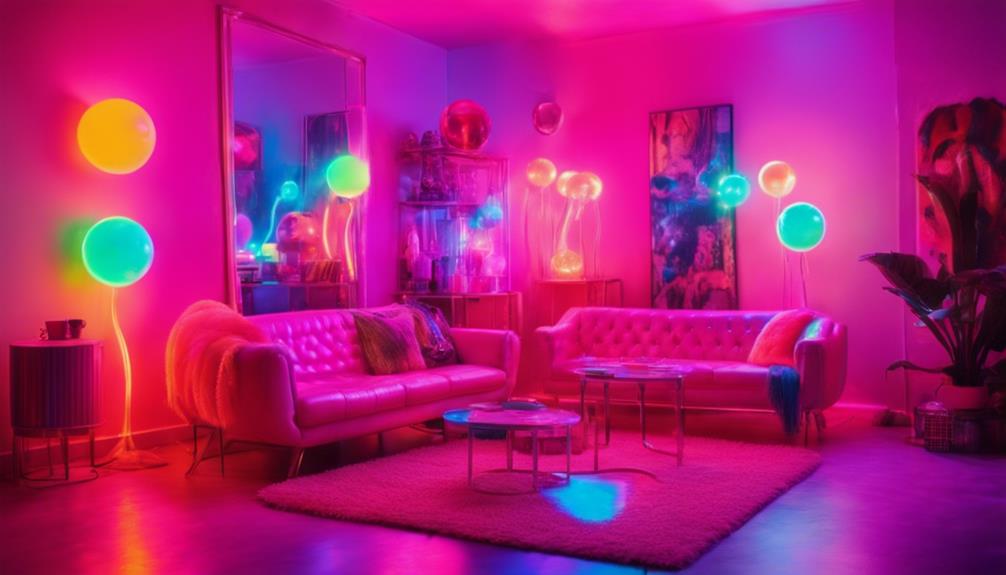
When it comes to lighting, you're in for a treat with options like disco ball floor lamps and neon color-changing LED strips that instantly elevate your Y2K vibe.
A glowing lava lamp accent can bring a nostalgic touch, while a colorful pendant light fixture adds a fun focal point to your space.
Let's explore how these lighting ideas can transform your room!
Disco Ball Floor Lamp
Transforming your space with a Disco Ball Floor Lamp instantly brings a playful, vibrant energy that captures the essence of Y2K style. This retro-inspired lighting fixture combines charm with modern functionality, featuring a reflective surface that casts stunning light patterns throughout the room.
Imagine the colorful ambiance reminiscent of early 2000s dance parties, all while enjoying energy-efficient LED technology.
You'll find Disco Ball Floor Lamps in various styles, including adjustable heights and multi-color options, making them ideal for any room size or theme. Whether you're revamping your living room or creating a cozy corner for relaxation, these lamps serve as versatile decor pieces that stand out.
Incorporating a Disco Ball Floor Lamp into your decor not only evokes nostalgia but also creates an eye-catching focal point. Pair it with bright colors and funky patterns to enhance the Y2K vibe.
The playful nature of this lamp perfectly aligns with the exuberant spirit of Y2K design, making it a must-have addition for anyone looking to impress friends with a fun and vibrant atmosphere.
Neon Color-Changing LED Strip
Neon color-changing LED strip lights instantly elevate your space with vibrant hues, allowing you to customize the mood and energy of any room.
These strips are a fantastic addition to your Y2K-themed decor, bringing a playful ambiance that perfectly captures the energetic nostalgia of the early 2000s. Available in lengths from 16.4 feet to 32.8 feet, you can easily install them on walls, ceilings, or even furniture to create a unique lighting scheme.
Many neon color-changing LED strips come with remote controls or app functionality, so you can switch colors, adjust brightness, and set dynamic effects with ease. Imagine shifting from a calm blue for relaxation to a lively pink for a party atmosphere—all at the push of a button.
Incorporating these LED strips not only adds a modern touch but also reflects the era's love for flashy artificial lighting and bold color palettes.
Whether you're looking to impress friends or just enjoy a vibrant living space, these neon color-changing LED strips are a must-have for your Y2K room revival.
Glowing Lava Lamp Accent
Glowing lava lamps add an enchanting charm to your Y2K room, creating a mesmerizing interplay of colored wax that enhances the nostalgic atmosphere. These iconic pieces of decor are perfect for bringing a retro vibe to your space, as they flow gracefully in their liquid environment. You can find lava lamps in various colors and sizes, each offering a unique glow that's sure to warm up your room.
Using incandescent or LED bulbs, a lava lamp provides a soft, inviting light that complements your playful decor. Not only do they light up your space, but they also spark conversations with friends, reflecting the quirky essence of early 2000s aesthetics.
To maximize their impact, consider pairing your lava lamp with other lighting elements like neon signs or fairy lights. This combination creates a vibrant and dynamic lighting scheme that captures the essence of Y2K style.
As their popularity continues to rise, adding a glowing lava lamp to your room is an effortless way to embrace the nostalgic vibe of the early 2000s while impressing everyone who steps inside!
Colorful Pendant Light Fixture
Colorful pendant light fixtures can instantly elevate the vibe of your Y2K room, adding a playful splash of brightness that captures the essence of early 2000s aesthetics. These eye-catching pieces often come in vibrant hues like pink, blue, and neon shades, perfectly aligning with the Y2K color palette and sparking nostalgia for that era.
Look for retro-inspired shapes and materials, such as acrylic or glass, to evoke the unique styles characteristic of early 2000s decor. An adjustable brightness feature is a great addition, allowing you to set the mood according to your activities—whether you're hosting a chill movie night or throwing a fun dance party.
To enhance the overall look of your Y2K aesthetic room, pair your colorful pendant light fixture with other retro elements, like beaded curtains or funky rugs. This combination creates a cohesive and dynamic atmosphere that truly reflects the playful spirit of the 2000s.
Decorative Elements
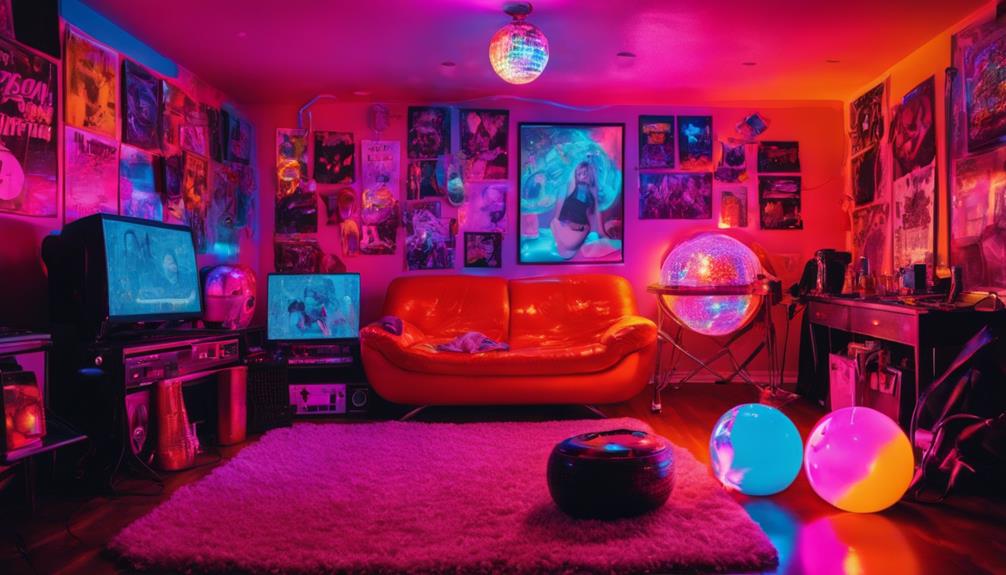
To really capture the Y2K vibe, you'll want to add some eye-catching decorative elements.
Glittery star wall stickers and iridescent butterfly wall decals can transform your space into a playful wonderland.
Don't forget to create a retro Polaroid photo wall that showcases your favorite memories in style!
Glittery Star Wall Stickers
Nostalgic for the playful essence of the Y2K aesthetic, glittery star wall stickers add a vibrant touch to any space. These eye-catching decals capture the fun and whimsy of the 2000s, featuring shimmering finishes and a variety of vibrant colors that instantly brighten up your room.
You can easily apply glittery star wall stickers to different surfaces, making them perfect for personalizing bedrooms, dorms, or creative spaces. Available in various sizes and designs, these stickers allow you to create whimsical collages or highlight specific areas of your walls for added visual interest.
They're an inexpensive and removable option, ideal for renters or anyone wanting to frequently change their decor without damaging the walls. Plus, when you pair glittery star wall stickers with other Y2K elements like neon lighting and inflatable furniture, you enhance that playful atmosphere even more.
Iridescent Butterfly Wall Decals
Iridescent butterfly wall decals bring an enchanting shimmer to your space, instantly elevating the Y2K vibe with their holographic finish. These stunning decals reflect light beautifully, creating a mesmerizing visual effect that can transform any wall into a whimsical masterpiece. You can easily apply and remove these decals without damaging your walls, making them a versatile choice for personalizing your room.
Available in various sizes and colors, iridescent butterfly wall decals allow you to arrange them in playful patterns or scatter them across your walls. This flexibility helps evoke the nostalgic atmosphere of the early 2000s, perfect for those wanting to embrace that aesthetic. Plus, they serve as a fantastic backdrop for photo opportunities, adding a fun and lively touch to your social media posts and room tours.
To create a cohesive look, pair these decals with other Y2K decor elements like neon lights and vibrant textiles. By incorporating iridescent butterfly wall decals, you'll not only enhance your space but also impress your friends with your stylish throwback design. So, get ready to fly into the 2000s with these delightful decorative elements!
Retro Polaroid Photo Wall
Creating a retro Polaroid photo wall is a fun way to showcase your favorite memories while capturing the playful essence of the early 2000s. Start by gathering your cherished Polaroid photos, then get creative with colorful washi tape or string lights to hang them in an eye-catching arrangement. This instantly adds a vibrant touch to your space.
Don't forget to include some motivational quotes or playful captions on a few Polaroids. These elements enhance the nostalgic vibe, reflecting the optimistic spirit of the Y2K aesthetic. You can also mix in stickers and small wall art to create an eclectic collage that embodies the whimsy of the 2000s.
To make the most impact, position your retro Polaroid photo wall in a prominent area of your room. This way, it serves as a focal point that not only showcases your personality but also sparks conversations with friends.
Flooring
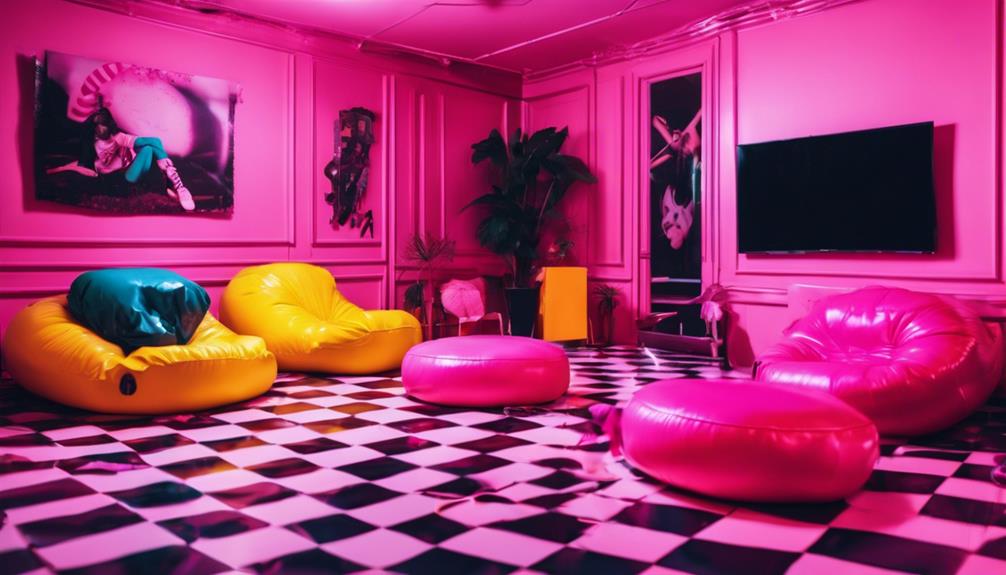
When choosing flooring for your Y2K room, think about glossy vinyl tiles that capture that retro feel effortlessly.
You might also consider a checkered pattern area rug or neon pink carpet tiles to add a playful pop of color.
These options not only reflect the early 2000s vibe but also create a fun and inviting atmosphere.
Glossy Vinyl Tile Flooring
Glossy vinyl tile flooring brings a shiny, reflective surface that perfectly captures the retro-futuristic vibe of Y2K aesthetics. If you want to create a space that screams early 2000s, this flooring choice is a must-have. Available in a variety of colors and patterns, glossy vinyl tiles can mimic the look of ceramic or stone while providing a softer, more comfortable underfoot experience.
Not only is glossy vinyl tile flooring stylish, but it's also practical. Its easy-to-clean surface makes maintenance a breeze, allowing you to spend more time enjoying your vibrant, nostalgic space. You can combine these tiles with bold patterns and colors to enhance that playful and eclectic nature typical of Y2K room decor.
Plus, the affordability and versatility of glossy vinyl tiles mean you can achieve that iconic early 2000s style without breaking the bank. Whether you're aiming for a funky dance floor vibe or a sleek, modern look, glossy vinyl tile flooring offers endless possibilities for customization.
Checkered Pattern Area Rug
A checkered pattern area rug instantly transforms your space with its bold visual statement, perfectly capturing the playful essence of Y2K decor. These rugs often feature contrasting colors like black and white or vibrant pastels, enhancing the eclectic vibe typical of the early 2000s. When you incorporate a checkered pattern rug, you not only evoke nostalgia but also create a stylish focal point in any room.
The texture of these rugs provides comfort, making them ideal for lounging areas or cozy bedrooms. You can choose from various materials, including soft plush or durable synthetic fibers, catering to your aesthetic preferences and practical needs. Whether you're relaxing with friends or simply enjoying your space, a checkered pattern area rug adds that extra flair.
Additionally, it pairs excellently with other Y2K elements, such as inflatable furniture and bright accessories, creating a cohesive look that impresses everyone. So, if you're looking to make a statement and bring back the excitement of the 2000s, a checkered pattern area rug is a must-have addition to your decor. You'll love the way it ties everything together!
Neon Pink Carpet Tiles
Neon pink carpet tiles bring a bold, energetic vibe to your space, perfectly capturing the playful spirit of Y2K decor. As an iconic flooring choice, these tiles embody the vibrant aesthetics of the early 2000s, making them ideal for a retro-inspired room.
You can easily install neon pink carpet tiles in various sizes, allowing you to create customizable patterns and layouts that reflect your individual style. Their bright color adds a fun pop to your decor, enhancing the nostalgic ambiance that defines this era.
Made from durable materials, these carpet tiles resist wear and tear, ensuring they maintain their striking appearance even with everyday use. When you pair neon pink carpet tiles with other Y2K elements like inflatable furniture and neon lighting, you'll create a cohesive, eye-catching aesthetic that's sure to impress your friends.
Can I Incorporate Grunge Elements into Y2K Room Design?
Yes, you can definitely incorporate grunge elements into Y2K room design to create an edgy atmosphere. Consider adding some vintage band posters, distressed furniture, and dark color schemes to bring the grunge room ideas for edgy atmosphere to life in your Y2K-inspired space.
Conclusion
Reviving the Y2K aesthetic in your room is all about embracing bold colors, quirky furniture, and nostalgic accents.
By mixing essential fixtures with playful lighting and unique decor, you'll create a space that's both stylish and fun.
Don't forget to pay attention to your flooring, as it can tie the whole look together.
With these ideas, you'll impress all your friends and make your room a true blast from the past!
So go ahead, let your creativity shine!
